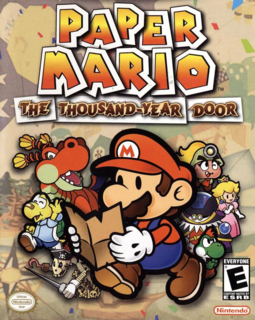Paper Mario: The Thousand Year Door is a worthy sequel to the flat-as-a-pancake-Mario franchise.
Story - The game opens with an introduction about a seaside town which was damaged by a cataclysm and consequently sunk into the depths of the earth. A town named Rogueport was later built at this site, with the fortunes of the lost kingdom fabled to exist behind the eponymous Thousand-Year Door, located in the ruins of the old town. Mario becomes involved when Princess Peach contacts him about a treasure map bought in Rogueport, but becomes part of a larger adventure when learning that Peach has gone missing. With the help of Goombella and Professor Frankly, Mario learns that the map can potentially reveal the location of the legendary seven Crystal Stars. Under the assumption that Peach herself is trying to find the stars, he uses the map in an attempt to locate her.
In actuality, Peach has been kidnapped by the X-Nauts, a species of alien led by Sir Grodus. While held captive, Peach uses e-mail via the computer TEC to inform Mario about the quest and consequently help him to attain all seven Crystal Stars and locate the treasure.
Characters - Paper Mario TTYD features classic character we all know and love like: Mario, Princess Peach, Luigi, and Bowser. And feature new characters to the franchise.
Partners - Like the last game, Mario has partners that help aid him in RPG battles, they are required to solve puzzles to advance progression in the game. The game continues the tradition of Paper Mario, in which Mario can be accompanied by one assistant character at a set time. There are seven party members in total: Goombella the Goomba, Koops the Koopa, Madame Flurrie, Yoshi (can be renamed), Vivian, Admiral Bobbery the Bob-omb, and Ms. Mowz, who is available as a secret character. All of these can assist Mario in combatting the game's primary antagonist, Sir Grodus, leader of the extraterrestrials known as the X-Nauts.
Gameplay - The Thousand-Year Door has a unique visual style. The graphics consist of a mixture of three-dimensional environments and two-dimensional characters who look as if they are made of paper. At different points in the game, Mario is "cursed" with abilities that enable special moves in the overworld, all of which are based on the paper theme. Mario can fold into a boat or a paper airplane by standing on a special activation panel, and roll up into a scroll of paper or become paper-thin. The game's environments also follow this theme; for example, illusory objects that conceal secret items or switches can be blown away by a gust of wind due to the environment's paper-like qualities. In certain parts of the game, the player controls Bowser in multiple side-scrolling levels based on Super Mario Bros.. Additionally, the player controls Peach in the X-Naut Fortress at the completion of most game chapters.
Battles in The Thousand-Year Door borrow elements from the original Paper Mario and Super Mario RPG: Legend of the Seven Stars. The turn-based system, in which players select an attack, defence, or item from a menu, is augmented by timed button presses that can result in substantial attack or defence bonuses when performed correctly. A similar system was also used in Mario & Luigi: Superstar Saga. In The Thousand-Year Door, each of Mario's party members now have their own Heart Points (HP) and may receive any attack that Mario can receive. When a partner's Heart Points are reduced to zero, the partner becomes inactive for the rest of that battle and later battles until recovery. If Mario's Heart Points are reduced to zero, however, the game ends. Flower Points-which are required for special moves-are shared among Mario and his party members. Defeating enemies awards various numbers of Star Points to Mario; for every 100 Star Points, Mario is able to level up, choosing between three statistical character enhancements. The battles take place on a stage in front of an audience; if the player performs well in a battle, the audience can assist Mario by replenishing star points, throwing helpful items on-stage, or inflicting damage on the opponent. Conversely, the audience may throw damage-causing items at the player or leave if the player performs poorly in a battle.
Outside of battle, the game contains some strong console role-playing game traditions. For example, Mario's strength is determined by multiple statistical fields and status-boosting items that can be used in and outside of combat. The effects of these items range from healing Mario or his partner to damaging the opponent. Mario can also purchase badges from non-player characters or occasionally obtain them from defeated enemies; when equipped, these badges can permanently enhance a particular skill or aspect. Throughout the game, Mario is permanently assisted by a party member. Each party member has a specialised skill. More party members are gained as the player advances through the game
Graphics - The game doesn't look a sheet of paper, but it shows clear, vivid, backgrounds with a paper-thin characters. Later in the game you can transform into different objects that you can make with a sheet of paper in real life. (Paper airplane, paper boat, etc.) The ideas in this game seem limitless to me.
Overall, Paper Mario: The Thousand-Year Door is a good game to play for all ages. The puzzles are challenging, but doesn't cheat you out no matter what age you are. I would recommend this game to anyone. Good luck, buuuuuuuuuuuuuuddy!!

